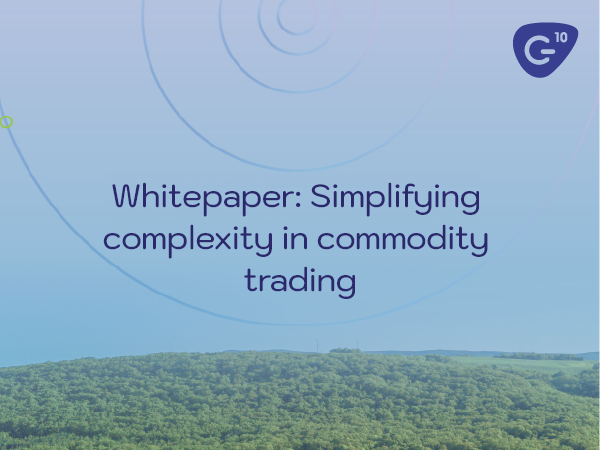Last week, we discussed some of the changes in the global shipping industry that are creating challenges for logistics professionals in commodity trading companies. Today, having explored the challenges, it is time to look at how they can be mitigated.
Integrating the different teams within your organisation – logistics, risk, trading, and finance, helps the organisation as a whole respond with greater agility. This agility provides business continuity in the face of disruption and allows individuals to act creatively and flexibly whilst still operating within your processes – maximising opportunities and minimising risk.
Integrating these multiple teams can be easier than you might at first expect, as modern Commodity Management Systems give you the flexibility to share data across teams in real-time with no need for any copying or retyping of information. If your current CTRM doesn’t have all the automation and time-saving functionality of a modern system, you have the option to upgrade your CTRM to a full Commodity Management System that incorporates all your business areas, creating a single source of truth and seamless business processes. Or, if your CTRM is working for your trading team, Commodity Management solutions can provide the integrations to seamlessly share data between the systems used by different teams.
The benefits of incorporating logistics and vessel tracking into a CTRM
Incorporating your logistics and CTRM software has many benefits for logistics operators, other teams, and the business as a whole. Some of these benefits include:
Real-time visibility
With a Commodity Management System like Gen10’s CommOS, logistics professionals can manage their entire responsibilities within the one system, with no need to jump between spreadsheets or copy information between pages and systems. Operators have a real-time view of all stock, including its quality data and allocation status, alongside the contracts they are allocating. They can also view and report on inventory changes straight away, whether it is in a warehouse or at sea.
And CommOS even allows you to incorporate vessel tracking software so that your team know where a specific container or shipment is, and ETAs are automatically updated within the system whenever they change in the real world.
This allows operators to make faster decisions based on all the information they might need, and further improves their efficiency by removing the administration and potential for errors that occur when working across multiple systems at the same time.
Faster handovers
Contracts can be handed from trading to operations teams via automated workflows as soon as they are approved. This means that everyone involved has visibility of the information being handed over, it is all in the system in the correct format and fields, and tasks can be allocated to one individual or team for clear accountability. Digital handovers are faster, more efficient and remove any ambiguity that can occur in email or spoken interactions.
Handovers from operations onwards are also much faster. When operators update the status of a shipment, for example, marking it as loaded or arrived, or your vessel tracking system receives an update, this can automatically trigger the next action in your workflows, whether this is to authorise an inspection, generate and send an invoice, or trigger other internal actions. Again, these activities can all be configured to alert other teams that the shipment or contract has now been handed over to them, without the need for any additional action from the operator.
Inventory management and traceability
Incorporating logistics into the CTRM system creates much more efficient inventory management. Firstly, it incorporates physical location management into your inventory processing and keeps all inventory management data in one place.
This also makes it much easier to manage quality data, allowing you to easily update valuations, pricing, and invoices alongside your physical inventories as inspections take place or as stock is combined into shipments. This quality data varies by commodity and can be highly complex, introducing inefficiencies and risks if you do not have the right management systems, as we recently explored in the case of cotton and metals.
Inventory management also plays a critical role in commodity traceability, which is also made much more straightforward and easier to verify when your data is all contained within one system. In addition, CommOS provides a complete audit trail of every action and update to stock as it is processed, so it can be traced across your entire operation, even if split, blended or combined. And the built-in certificate management means that any sustainability certifications are managed in the same way, with complete traceability.
Supply chain optimisation
Real-time data, faster access to information, and better inventory management all translate to better supply chain optimisation. Operators can ensure a faster asset turnover, meaning better use of resources and credit agreements, they can also reduce costs from supply chain inefficiencies and disruption. And without the need to copy information between systems, there is less potential for human error, which takes time away from value-creating activities and slows down supply chain tasks.
Risk management
As mentioned above, integrating operational data reduces many of the operational risks associated with human errors in the process. It also allows you to establish clear compliance workflows that progress your contracts across teams. Other risk management features in CommOS include checks and controls that ensure allocations are within contract tolerances, calendar notifications of deadlines, and more, to allow operators to act with freedom, providing more information to other teams than ever before, but also with less need to check in for verification or permission as all activities are contained within your agreed limits.
And of course, the live reports mean that risk teams and traders have access to all the data they need in position and risk reports, without operators having to take time to fill in reports, copy information, or respond to ad-hoc information requests. And the automatic audit trail of all activities and interactions provides clear verification for any risk processes or audits without intruding on busy individuals.
Conclusion
There are many benefits to incorporating logistics and vessel tracking into your CTRM system, whether that is through one system used across all your teams, or using solutions to share data between the various systems you are using. These benefits affect the entire business, improving the way each team works internally, communicates with others, and, ultimately, improving business outcomes and profitability.
If you’d like to understand more about software that helps your operations, trading and risk teams work together, find out more about CommOS here.
Want to read more?
Subscribe now for monthly updates
By submitting your details you agree that we can store your data and communicate with you. You can opt out of these communications at any time. Read all in our Privacy Policy.


